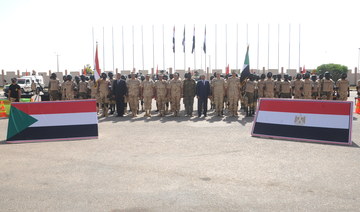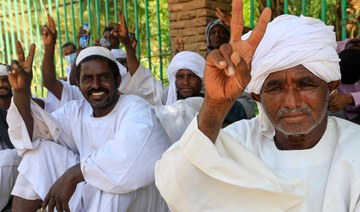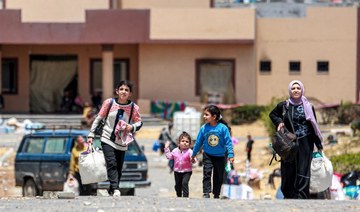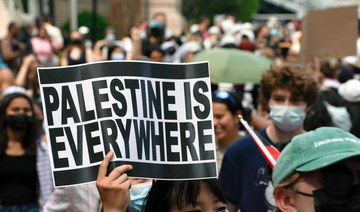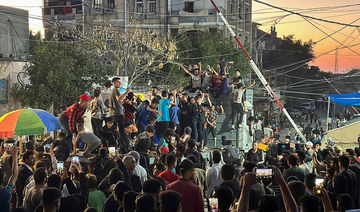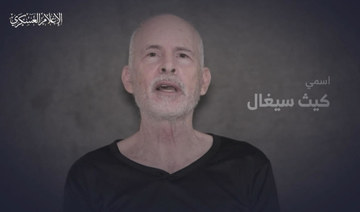KHARTOUM: Tens of thousands of supporters of Sudan’s transition to a civilian-led democracy took to the streets Thursday, as rival demonstrators kept up a sit-in demanding a return to military rule.
Both sides appealed to their supporters to keep apart and refrain from any violence, but there was a heavy police and troop presence around potential flashpoints.
Security forces fired tear gas as pro-civilian rule protesters rallied outside parliament in Omdurman, across the Nile river from the capital Khartoum, witnesses and an AFP correspondent said.
The two sides represent opposing factions of the Forces for Freedom and Change (FFC), the civilian umbrella group which spearheaded the nationwide demonstrations that led to the army’s overthrow of longtime president Omar Al-Bashir in 2019.
The mainstream faction backs the transition to civilian rule, while supporters of the breakaway faction are demanding that the military takeover.
Demonstrators joined the march organized by the mainstream faction in several cities across Sudan including Khartoum, its twin city Omdurman, Port Sudan in the east, and Atbara to the north.
Banners proclaimed “Civilian (rule) is the people’s choice,” while the marchers chanted slogans against Islamists and the military, the two main pillars of the former Bashir regime.
“Give up power, (Abdel Fattah) Al-Burhan,” they chanted in reference to the general who chairs the Sovereign Council, the joint civilian-military body which oversees the work of the transitional government.
“Burhan is dirty, and was installed by the Islamists.”
Jaafar Hassan, spokesman of the mainstream FFC faction, said supporters backed two key agreements — the 2019 power-sharing deal between the civilians the military, and a 2020 peace deal with rebel groups.
The two deals stipulate power will be handed over to civilian rule by the end of a three-year transition period in 2023.
“Our main goal is to have the military hand over the chairmanship of the Sovereign Council to the civilians,” Hassan told AFP. “We also want the armed groups to be integrated in the Sudanese army.”
Their rivals, the pro-military faction, have been holding a sit-in outside the presidential palace since Saturday.
It has drawn support from some of the many Sudanese who have been hit hard by the tough IMF-backed economic reforms implemented by Prime Minister Abdalla Hamdok, a former UN economist.
“We are in the right,” said protester Hamada Abdelrahman, standing outside the presidential palace. “This government has not offered the Sudanese people anything for two years.”
The sit-in’s opponents charge it has been orchestrated by leading figures in the security forces with the support of Bashir sympathizers and other “counter-revolutionaries.”
The same groups were blamed for a September 21 coup attempt that was thwarted by the government.
Ahead of Thursday’s demonstrations, leaders of the rival factions appealed for calm.
Ali Ammar, a leader of the mainstream FFC, said pro-government demonstrators would stay away from the presidential palace and the cabinet building, so “there would be no friction with protesters” there.
Prominent ex-rebel figures in the pro-military faction, like Darfur governor Minni Minnawi and Finance Minister Gibril Ibrahim, called for the rival demonstrations to remain peaceful.
On Thursday, troops and police sealed off roads leading to the large open space outside army headquarters, where tens of thousands of protesters camped out for weeks before and after Bashir’s ouster in April 2019.
Hamdok has described the deep divisions over Sudan’s transition as “the worst and most dangerous” since Bashir’s overthrow.
The prime minister has made his top priorities addressing the chronic economic woes inherited from the Bashir regime, and making peace with the multiple rebel groups that took up arms during its three decades in power.
A sharp improvement in relations with the United States has led to the lifting of economic sanctions giving some help to the economy.
But a package of painful structural reforms, including the slashing of fuel subsidies and a managed float of the Sudanese pound, has proved widely unpopular and has cost Hamdok’s government much of its support.
In October last year, the government signed a peace deal with multiple rebel groups in Sudan’s far-flung regions with a view to ending the ethnic conflicts that have dogged the country since independence.
The deal was widely hailed as a step forward, but its focus on the three battleground regions of Darfur, Blue Nile and South Kordofan left minority communities in other parts of Sudan feeling sidelined.
Resentment has been particularly strong among the Beja people of the Red Sea coast, who have mounted protests across the east since mid-September, including a blockade of the key trade hub of Port Sudan.
Rival Sudan camps take to streets as tensions rise
https://arab.news/2vxjw
Rival Sudan camps take to streets as tensions rise
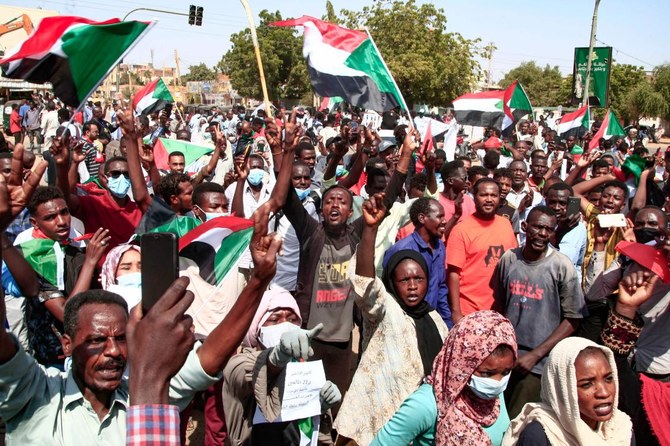
- Security forces fired tear gas as pro-civilian rule protesters rallied outside parliament in Omdurman
- Demonstrators joined the march organised by the mainstream faction in several cities across Sudan including Khartoum
Palestinian militants say they fired rockets from Gaza on Israel
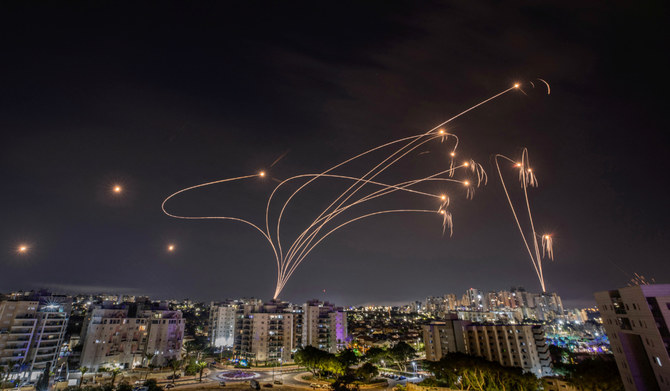
- The Israeli army said sirens sounded in communities near the Gaza Strip
- Israel has killed more than 34,600 Palestinians in Gaza, mostly women and children, according to the health ministry in the Hamas-run territory
GAZA CITY: The Palestinian Islamic Jihad’s armed wing said its militants had launched rockets from Gaza toward southern Israel on Monday in response to Israeli air strikes on the Palestinian territory.
“We have targeted Sderot, Nir Am, and settlements in the Gaza envelope with rocket barrages,” the Al-Quds Brigades said in a statement, referring to a zone of southern Israel close to Gaza.
The Israeli army said sirens sounded in communities near the Gaza Strip.
Erdogan opens former church to Muslim worshippers
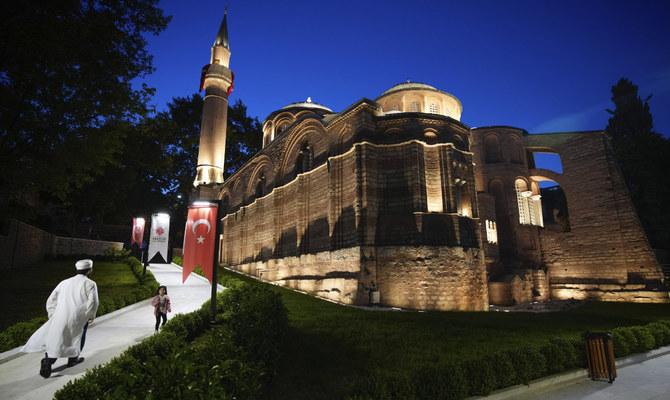
- Erdogan on Monday declared Kariye Mosque reopened for worship, remotely during a ceremony at the presidential palace in the capital, Ankara
ISTANBUL: Turkiye on Monday reopened a mosque converted from an ancient Orthodox church in Istanbul for Muslim worship, four years after the president ordered its transformation.
The Kariye Mosque was formerly a Byzantine church, then a mosque and then a museum.
President Recep Tayyip Erdogan, in 2020, ordered the building to be reconverted into a Muslim place of worship.
His order came followed a similarly controversial ruling on the UNESCO-protected Hagia Sophia — a cathedral in Istanbul that was converted into a mosque and then a museum, before becoming a mosque again.
The changes were seen as part of Erdogan’s efforts to galvanize his more conservative and nationalist supporters.
But they have also added to tensions with prelates in both the Orthodox and Catholic churches.
Erdogan on Monday declared Kariye Mosque reopened for worship, remotely during a ceremony at the presidential palace in the capital, Ankara.
An AFP picture from the mosque showed one worshipper wave a Turkish flag before the congregation who performed their prayers on a brick-red color carpet on Monday afternoon.
Images also revealed that two mosaics carved into the walls of the ancient church on the right and left sides of the prayer room were covered with curtains.
Most of the mosaics and frescos however remained visible to visitors.
“I had the opportunity to visit the place before and I was initially a little afraid of the work that could have been carried out,” said Michel, a French tourist, who would not give his full name.
“But ultimately we must recognize that it’s well done, that the frescos are accessible to everybody,” the 31-year-old researcher said.
Greece’s foreign affairs ministry on Monday night blasted a “provocation,” claiming that the move “alters the character” of the former church and “harms this UNESCO world heritage site that belongs to humanity.”
Neighbouring Greece had already reacted angrily to the decision in 2020 to convert the building.
The Holy Savior in Chora was a Byzantine church decorated with 14th-century frescoes of the Last Judgment that are still treasured by Christians.
The church was converted into Kariye Mosque half a century after the 1453 conquest of Constantinople by the Ottoman Turks.
It became the Kariye Museum after World War II, when Turkiye sought to create a more secular republic from the ashes of the Ottoman Empire.
A group of art historians from the United States helped restore the original church’s mosaics and they were put on public display in 1958.
Hagia Sophia — once the seat of Eastern Christianity — was also converted into a mosque by the Ottomans.
Ataturk, the founder of modern Turkiye after World War I, turned the UNESCO World Heritage site into a museum in a bid to promote religious neutrality.
Nearly 100 years later, Erdogan, whose ruling AKP party has Islamist roots, turned it back into a Muslim place of worship.
“It’s timeless, it’s something that for me is superior to Hagia Sophia,” Michel said of Kariye Mosque.
“It’s better preserved, less touristic and more intimate.”
Jordan’s King Abdullah presses Biden to avert Israel offensive in Rafah
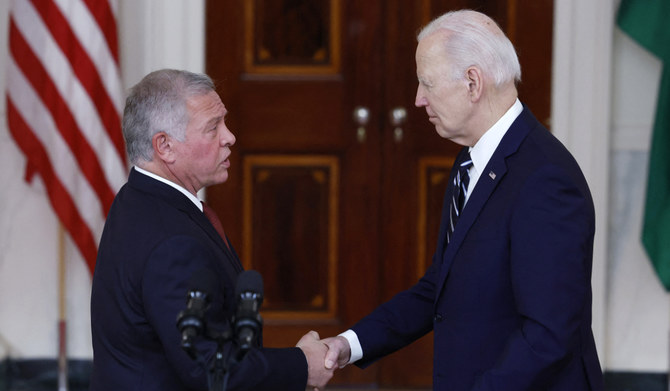
- Israel has killed more than 34,000 Palestinians, according to Gaza’s Health Ministry
- The Biden administration and Israeli officials remain at odds over Israel’s planned military incursion in the southern Gaza city of Rafah where it told Palestinians to start evacuating some parts on Monday
WASHINGTON: Jordan’s King Abdullah told US President Joe Biden in a private meeting on Monday that an Israeli offensive in Rafah would lead to a “new massacre” of Palestinian civilians and urged the international community to take urgent action.
“The king warned of the repercussions of the Israeli ground offensive on Rafah, which could cause a regional spillover of the conflict,” a statement from the Jordan royal court said after Abdullah had lunch with Biden at the White House.
Israel carried out airstrikes in Rafah on Monday and told Palestinians to evacuate parts of the city where more than a million people uprooted by the seven-month war are crowded together.
On Sunday, Hamas reiterated its demand for an end to the war in exchange for the freeing of hostages, and Israeli Prime Minister Benjamin Netanyahu flatly ruled that out. Hamas also attacked the Kerem Shalom crossing into Gaza, which Israel said killed three of its soldiers.
In a phone call on Monday with Israeli Prime Minister Benjmain Netanyahu, Biden pressed Netanyahu not to go ahead with a large-scale Israeli military offensive in Rafah. The US president has been vocal in his demand that Israel not undertake a ground offensive in Rafah without a plan to protect Palestinian civilians.
The Jordanian statement said Abdullah in his meeting with Biden “warned that the Israeli attack on Rafah, where 1.4 million Palestinians are internally displaced as a result of the war on Gaza, threatens to lead to a new massacre.”
“His Majesty stressed the importance of all efforts that seek an immediate ceasefire in Gaza,” it said. “The king and the US president affirmed their commitment to working to reach a sustainable ceasefire in Gaza, stressing the importance of facilitating the delivery of sustainable humanitarian aid to the Strip in light of the dire needs.”
The Biden administration and Israeli officials remain at odds over Israel’s planned military incursion in the southern Gaza city of Rafah where it told Palestinians to start evacuating some parts on Monday.
Biden last met King Abdullah at the White House in February and the two longtime allies discussed a daunting list of challenges, including the looming Israeli ground offensive in southern Gaza and suffering of Palestinian civilians. Jordan and other Arab states have been highly critical of Israel’s actions and have been demanding a ceasefire since mid-October as civilian casualties began to skyrocket.
The war began after Hamas stunned Israel with a cross-border raid on Oct. 7 in which 1,200 people were killed and 252 hostages taken, according to Israeli tallies.
More than 34,600 Palestinians have been killed and more than 77,000 wounded in Israel’s assault, according to Gaza’s health ministry.
What’s in the three-phase ceasefire deal Hamas backs, but Israel does not?
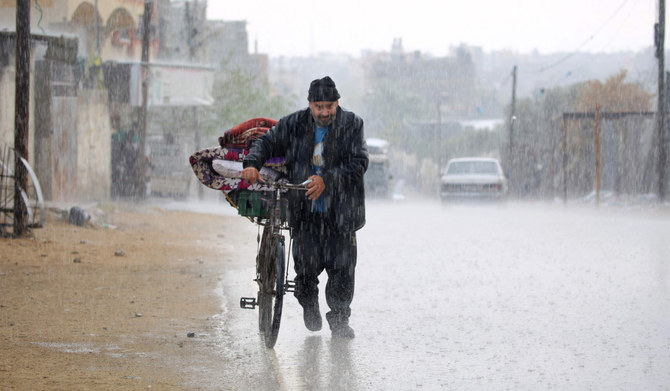
- Israel has killed more than 34,000 Palestinians, according to Gaza’s Health Ministry
CAIRO: Palestinian Islamist group Hamas said on Monday it had agreed to a three-phased deal for a ceasefire and hostages-for-prisoners swap, although an Israeli official said the deal was not acceptable to Israel because terms had been “softened.”
The United States, which alongside Qatar and Egypt has played a mediation role in the talks, said it was studying the Hamas response and would discuss it with Middle East allies.
Based on details announced so far by Hamas officials and an official briefed on the talks, the deal that the Palestinian group said it had agreed to included the following:
PHASE ONE
• 42-day ceasefire period
• Hamas releases 33 Israeli hostages in return for Israel releasing Palestinians from Israeli jails.
• Israel partially withdraws troops from Gaza and allows free movement of Palestinians from south to north Gaza.
PHASE TWO
• Another 42-day period that features an agreement to restore a “sustainable calm” to Gaza, language that an official briefed on the talks said Hamas and Israel had agreed in order to take discussion of a “permanent ceasefire” off the table.
• The complete withdrawal of most Israeli troops from Gaza.
• Hamas releases Israeli reservists and some soldiers in return for Israel releasing Palestinians from jail.
PHASE THREE
• The completion of exchanging bodies and starting the implementation of reconstruction according to the plan overseen by Qatar, Egypt and the United Nations.
• Ending the complete blockade on the Gaza Strip.
Ex-Gaza hostages in Auschwitz for March of the Living
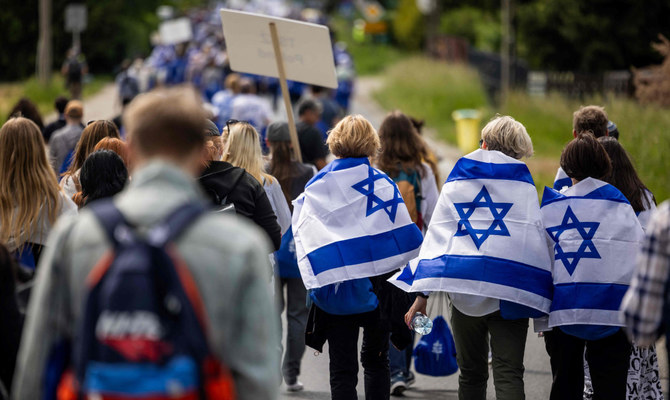
- One million European Jews died at the camp between 1940 and 1945 along with around 80,000 non-Jewish Poles, 25,000 Roma and 20,000 Soviet soldiers
OSWIECIM, Poland: Released Gaza hostages joined Holocaust survivors on Monday for an annual march in southern Poland to commemorate victims of the Auschwitz-Birkenau death camp.
Survivors of the October 7 attack on Israel by Hamas also joined the “March of the Living” at the site, which has become a symbol of Nazi Germany’s genocide of European Jews.
“I came to show that we’re alive and that we’ve built a country,” Bella Haim, 86, told AFP.
Her grandson Yotam Haim was captured by Hamas militants on October 7 and later gunned down in Gaza by Israeli soldiers who failed to realize he had escaped from his captors.
“I told myself that I couldn’t remain silent and I’m marching here in the name of my grandson Yotam and the victims” of the attack, Bella said.
She was part of an Israeli delegation that flew to Poland for the march in the southern city of Oswiecim, which numbered around 8,000 people this year.
Every year, Jews and non-Jews from around the world take part in the event at the site of the former death camp, which was built by Nazi Germany after it invaded Poland.
One million European Jews died at the camp between 1940 and 1945 along with around 80,000 non-Jewish Poles, 25,000 Roma and 20,000 Soviet soldiers.
The camp was liberated by the Red Army in January 1945.
This year’s March of the Living was briefly disrupted by pro-Palestinian protesters who spoke out against what they called Israel’s “genocide” in Gaza.
The war in Gaza broke out after Hamas’s unprecedented October 7 attack on Israel, which resulted in the deaths of more than 1,170 people, mostly civilians, according to an AFP tally of Israeli figures.
The militants also took some 250 hostages, of whom Israel estimates 128 remain in Gaza. The army says 35 of them are dead.
Vowing to destroy Hamas, Israel’s retaliatory offensive has killed at least 34,735 people in Gaza, mostly women and children, according to the Hamas-run territory’s health ministry.



